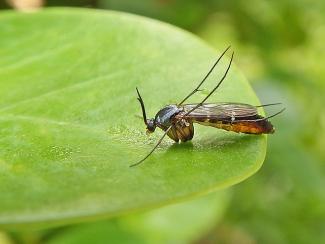
Image Credit: Ian Jacobs
Fungus-gnats (Mycetophilidae, Sciaridae) – fungivores. Sciarid gnats are probably the most abundant terrestrial flying insect in the Andrews Forest; they occur in the litter layer of the forest soil at densities of hundreds per square meter. It is probably mostly correlated with these incredible densities that so many are found in flowers; in the flower, they seem to spend most of their time immobile, so are presumably are not important pollinators. Under the forest canopy, where most of the flower-visiting guilds do not stray, they may yet have an unproven pollination role. Mycetophilids are seldom found in flowers, but there is literature supporting their role as specialized pollinators of the piggy-back saxifrage (Tolmiea).
The fungus-gnat genus, Gnoriste, is unique in possessing an extremely long tongue, presumably used for gathering nectar. Two of the independent studies on the pollination of Tolmiea have postulated that Gnoriste is a faithful pollinator of the “fungal-smelling flowers”, at least during the early part of the mushroom season when the fruiting bodies are not yet mature. The genus Gnoriste is very widespread in the North Temperate Zone, and obviously must be visiting other genera throughout the world.




True fungus gnats with their distinctive hunchbacks and the smaller sciarids both have the primitive multi-segmented antennae. Gnoriste on the left has the unusually long tongue, whereas the sciariods on the right never have any but the smallest mothparts.